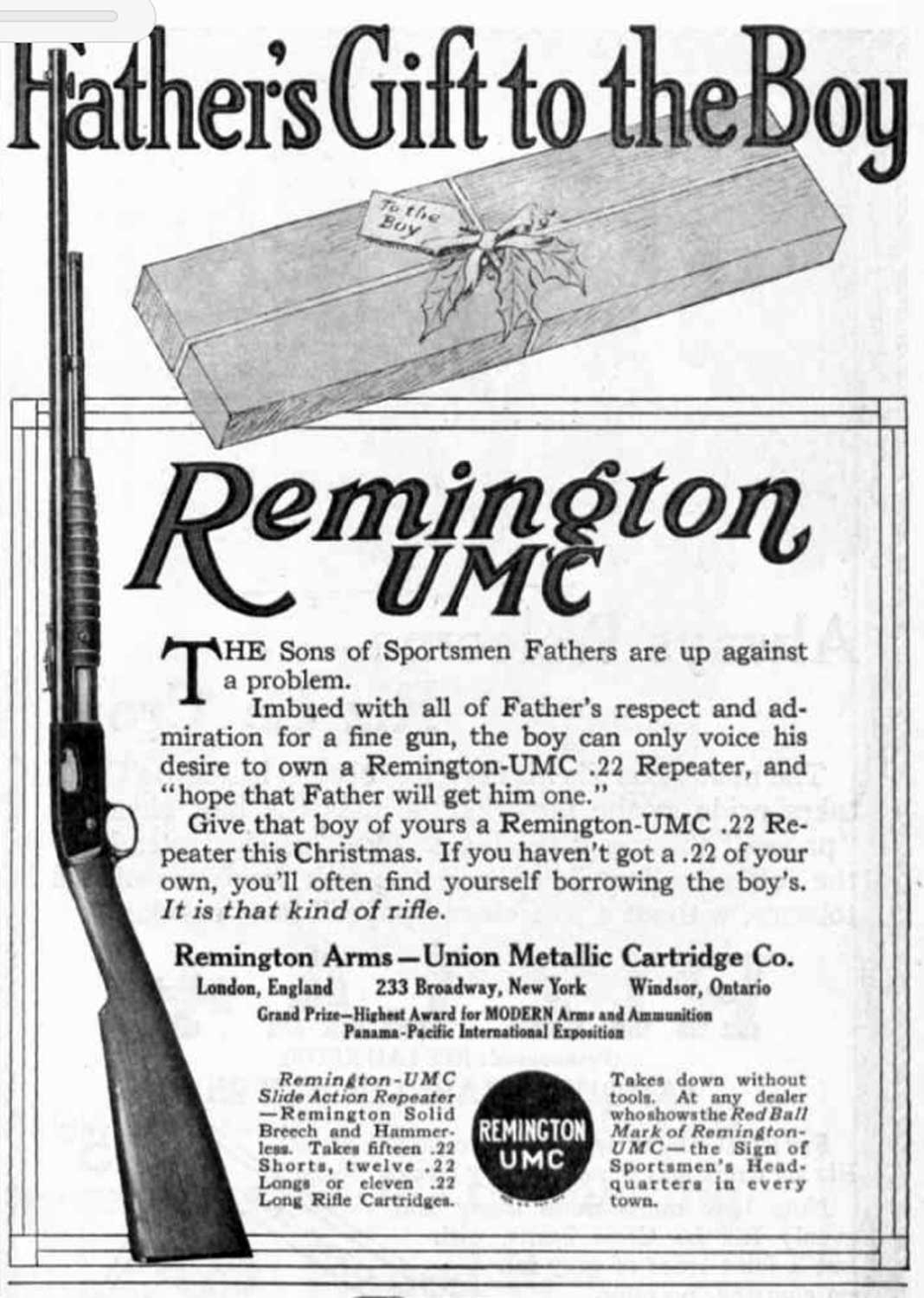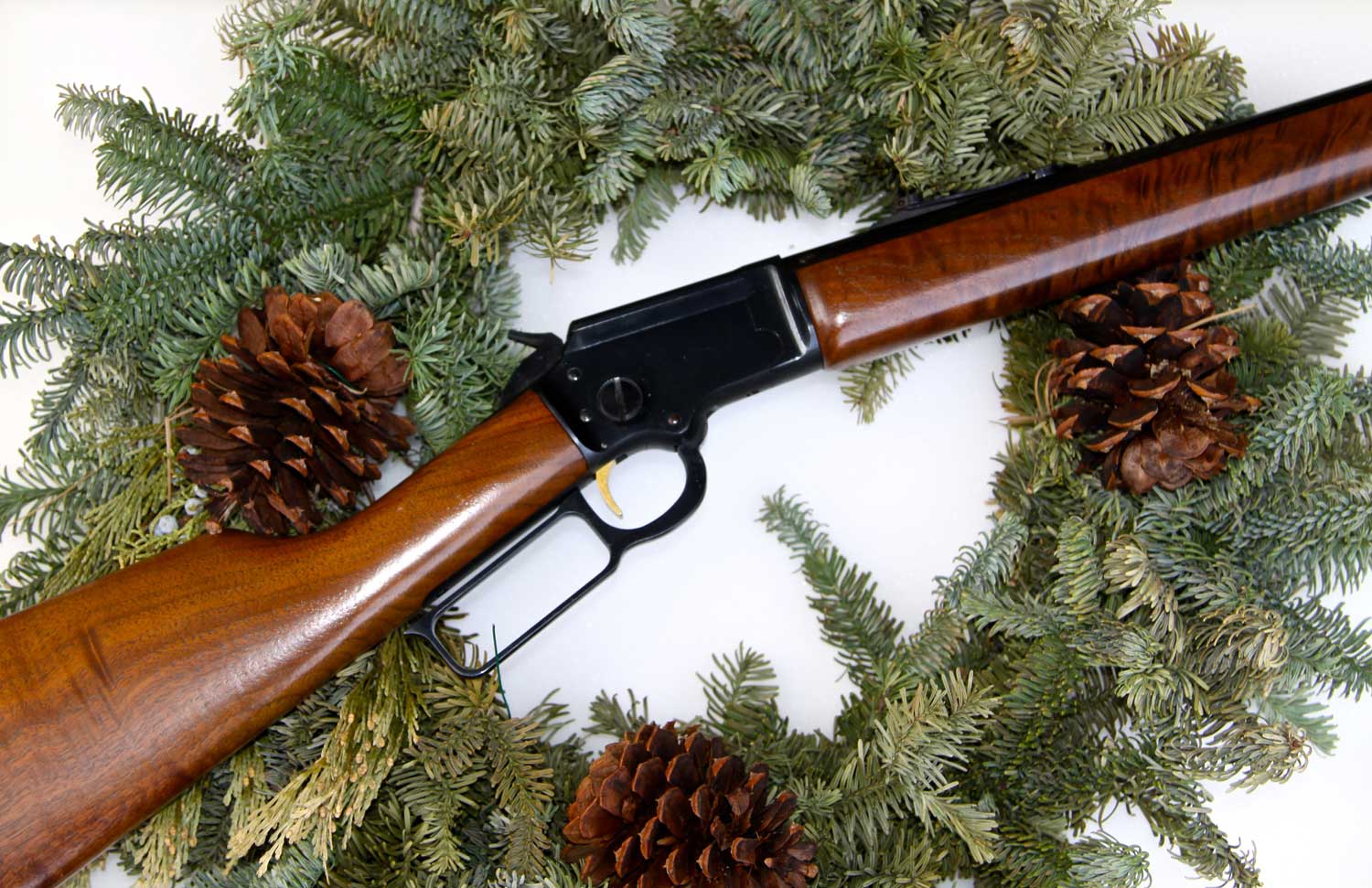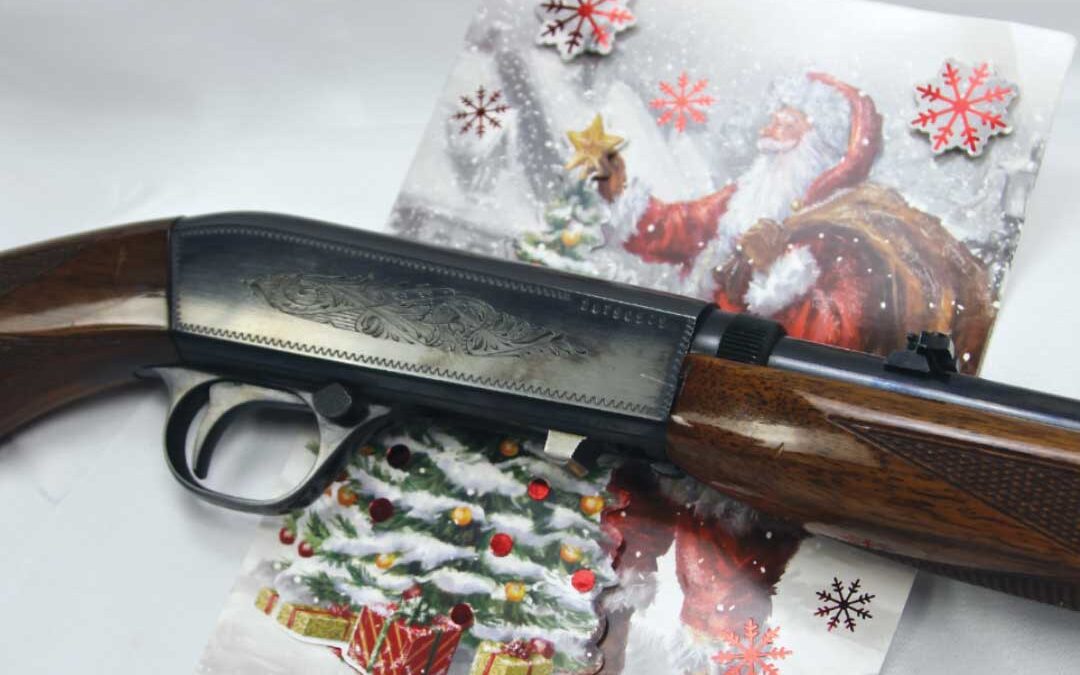Could there be anything more American than a boy receiving his first 22-caliber rifle on Christmas morning? Ah, the excitement, the early awakening before the rest of the household. The faint rustling of paper downstairs—was it the dog rummaging through the wrappings or—gulp!—was Santa still there, running a little late in his nocturnal rounds, taking a chance of being discovered just so he could leave that brightly wrapped and ribboned, elongated box that you knew had to be your long-awaited 22-caliber rifle—your first—because Dad had hinted you might have come of age and that you possibly, maybe, perhaps, were finally old enough to have your very own gun?
 Ever since the early 20th century, ads in various outdoors-themed magazines boasted of it. A 1909 issue of Sports Afield touted an advertisement for the J. Stevens Arms & Tool Company depicting a long bearded and goggle-wearing Santa landing one of those new-fangled flying machines on a rooftop, right next to some lucky boy’s chimney, with the headlines “The Right Firearms for Xmas… Ideal Xmas gifts are the time-honored Favorite No. 17 Rifle….” More than a million of these affordable but highly accurate rifles were made from 1893 until 1939, and you can bet a lot of those were unwrapped on Christmas morning.
Ever since the early 20th century, ads in various outdoors-themed magazines boasted of it. A 1909 issue of Sports Afield touted an advertisement for the J. Stevens Arms & Tool Company depicting a long bearded and goggle-wearing Santa landing one of those new-fangled flying machines on a rooftop, right next to some lucky boy’s chimney, with the headlines “The Right Firearms for Xmas… Ideal Xmas gifts are the time-honored Favorite No. 17 Rifle….” More than a million of these affordable but highly accurate rifles were made from 1893 until 1939, and you can bet a lot of those were unwrapped on Christmas morning.
Then there was the 1915 Remington ad with the headline, “Father’s Gift to the Boy” showing a Remington Model 12 pump-action 22 Rimfire rifle along with an oblong box that obviously contained that highly anticipated treasure. Two years later, a full page Winchester ad in the Saturday Evening Post (ah, those were the days!) showed a proud young lad admiring his brand new Winchester Model 90 pump-action in front of the fireplace with the headline, “Make this Christmas ‘the best ever’ for your boy,” while underneath, the copy rightfully proclaimed, “The longing for a rifle is the heritage of every American boy…. You remember, don’t you, how much you wanted a gun, how discontented you were ’til you got it?” Ah, I remember it well, although those ads were quite a bit before my time.
However, as a teenager back in the late 1950s and early ’60s, I had my own era of wish books in the form of every gun magazine I could get my hands on—from American Rifleman and Guns & Ammo to Outdoor Life, Field & Stream and even Argosy. And every year most of those November and December issues were filled with ads showing boys my age getting 22-caliber rifles for Christmas—Marlin, Remington, Mossberg and Winchester rimfires under the tree or surrounded by holly or poking out of Santa’s sack. But alas, to my frustration, those were inspired youthful longings that, for me, never turned into reality.
The hard, cold fact is that, unlike millions of luckier kids across the country, I never had a .22 as a young boy, let alone received one for Christmas which, as everyone who ever read those gun magazines knows, is the ideal time for getting such a treasured gift. However, there was a reason I didn’t bask in the pride of having a post-Christmas rimfire in my closet or mounted across a pair of aluminum horseshoe gun racks on my bedroom wall. It all stems from the fact that I spent the formative years of my life raised in Chicago, which was not (and still isn’t) a particularly firearms friendly town and, to make matters worse, I was brought up in a non-gun household. It wasn’t anti-gun. It’s just that no one in my immediate family owned a firearm. Plus, my mother had divorced my father when I was still in swaddling clothes, so there was never anyone to take me hunting. Or even plinking—as if anyone could legally “plink” within the Chicago city limits anyway.
Although I had two uncles, one was indeed anti-gun (a lawyer by profession who once sat me down in his living room and lectured me on the evils of firearms ownership and then did a double back-flip in exasperation when he found me reading a copy of Ed McGivern’s book Fast & Fancy Revolver Shooting. My other uncle—the “good” one—did in fact own a 22-caliber rifle, but lived miles away and besides, he had his own kids to take care of, although I don’t recall any of them ever getting a yuletide rifle either.
As a result, my first memorable whiff of the intoxicating smell of burnt gunpowder wafting through the air was accompanied by the crack-crack-clang! from some well-used Winchester 90s and Remington Model 12s as various young marksmen scored occasional hits on moving metal targets at the Chicago Fair shooting galleries. Other than that, the only other guns I ever saw were on the silver screen B Western matinees I eagerly watched every Saturday. Ten cents bought double features of non-stop Winchesters and Colts blazing away without ever needing to be reloaded. And thus, in those early years, Christmases came and went, with nary a .22 from Santa—or anyone else, for that matter. Actually, when I think about it, it’s amazing I grew up to be a gunwriter.
It may have all started just before I was about to enter high school and my mother decided it was time for her to remarry. Unfortunately, the guy she picked turned out to be a complete loser (they were later divorced) but it did result in our moving to Phoenix, Arizona. Unlike Chicago, here at last was gun country. In fact, for the first few years, I was convinced all Ford pickups came from the factory with a gun rack and a Winchester 94 carbine hung across the back window as standard equipment. Heck, even the waitresses at Bill Johnson’s Big Apple restaurant wore sixguns strapped to their shapely hips.

The Marlin Model 39 was the longest continuously produced 22-caliber rifle in the world and has been a favorite Christmas rifle for millions of boys. Unfortunately, with the closing of the Remington/Marlin production facilities in 2022, it is not currently being produced.
I soon began frequenting the many gun stores in the area at that time—Wade’s Gun Room, Tom Moody’s Stop ’N Swap, Pinney & Robinson’s—just to name a few. I also became a member of my high school Junior ROTC rifle team and joined a target shooting group that helped me obtain my first rifle, a Remington 514 single shot .22 that I had outfitted with Lyman peep sights. It wasn’t a Christmas rifle (I knew I wasn’t ever going to get anything like that with my current family situation), but it was the start of what would become a respectable gun collection in later years. Eventually, I started a fast draw club with my fellow teenaged friends called The Arizona Young Guns (the sport was starting to blossom back then).
It was also around that time when I began my writing career, starting with winning the Boy’s Life National Writing Contest with a western short story entitled, “The Cowboy and the Steer.” As this was well before computers, my prizes were a Remington portable typewriter and a Parker fountain pen—both of which I still have (although I stopped using the typewriter years ago). Unfortunately, by the time I started attending Arizona State University, the situation on the home front and my relationship with the miscreant my mother had married had deteriorated even further. But thankfully I had an after-hours job as night manager and chef at Nib’s—a hamburger restaurant on Camelback Road—which provided me with enough money to eventually buy a well-used 1950 Plymouth coupe that I hid in an alley in preparation for my “great escape.” At the proper time, I snuck out of the house with what few clothes I could pack, and ran away—or rather, drove away—from home and never went back. My first Christmas on my own I bought a tiny Christmas tree for my equally tiny apartment but couldn’t afford a rifle to put under it.
Fast forward two decades later. I am happily married to my college sweetheart, we have two cats, purchased a house and I am writing for magazines that include Guns & Ammo, American Rifleman, Gun Digest and Playboy, among others. Early one December evening, after my wife and I had just finished decorating our Christmas tree that stretched up to the knotty pine rafters of our den and flanked on either side by “Edgar” the 6-point elk and “Beauregard” the bison, I gazed at the colorfully festooned tree covered with ornaments and brightly wrapped in gold garland, and began telling my always patient, understanding and super-tolerant wife once more about the .22 rifle I never got for Christmas. But before she could once again stop me, I stopped myself mid-sentence, for I was suddenly struck with an amazing idea.
Why go on prolonging this agony for both of us every holiday season? This year I would stop my annual whining and would finally buy a Christmas .22 rifle for myself! A brilliant solution, I reasoned, perhaps bordering on genius. Alas, I failed to take heed of that prophetic admonition from Aesop’s Fables: “Be careful of what you wish for….” But blinded by my newfound excitement, I was oblivious to this dire warning.
With not much time to lose—after all Christmas was getting closer every day—I began making a list. A .22 rifle, yes, but which one? I already had a Marlin 39 and a Winchester Model 90, so they were disqualified. I also owned a Winchester 62A. I had sold my Stevens Crackshot a few years ago and my new Ruger 10/22 was barely out of the box. Looking for inspiration, I began perusing the latest gun magazines and my stack of older catalogs. Flipping through the pages, my gaze was suddenly fixated upon a classic 22 Rimfire I didn’t have, but a rifle that Santa would surely have brought me, if only he’d known—the Browning 22 Automatic Rifle, or the SA-22 in its more formal designation. Here, at last, was a classic .22, the first regularly produced semi-automatic rifle to be chambered in 22 Rimfire—originally in either 22 Short, which has been discontinued, or 22 Long Rifle, which is still in production (it never was factory chambered in 22 Long).
“The ideal plinker for every member of your family,” heralded a pine bough-enhanced ad with the headline, “Give A Browning” from an old November 1959 issue of Sports Illustrated depicting the graceful 22 Automatic. “Just the right size.” The ad went on. “Only 4 1/2 pounds and perfect balance make good shooting easy. Rugged all steel construction. Accepts scope mounts. Takes down to just 19 inches for convenient packing or storage. Many safety features….”
Easy shooting, raid-fire capability, rugged construction, take-down features, bottom ejection—what more could you want? This was one of John Browning’s most gracefully designed firearms. First produced in 1914 but not imported into the U.S. until 1954, this svelte little rifle, with its modernistic, simplistic form, defied its age. Initially manufactured in Belgium by FN Herstal until 1973, production then switched over to Miroku in Japan where it remains today. There are currently three versions being offered: Grade I, blued with modest hand embellished laser engraving; Grade II, featuring an engraved, satin-finished chromed receiver with octagon barrel; and Grade IV, with a full coverage foliage engraved grayed or blued receiver accented on both sides with 24 karat gold small game scenes. You probably noticed there is no longer a Grade III, which had a deeply engraved brushed chrome receiver with elaborate dog and game bird scenes, but it was discontinued in 1983 and now commands a premium on the secondary market.
Inasmuch as I was going be footing Santa’s bill for my Christmas present, I opted for the Grade I rifle. However, with December 25 looming ever larger on the calendar, there wasn’t enough time for me to contact my usual sources in hopes of conjuring up a discount. But as fate would have it, my local sporting goods store was advertising a holiday sale, and the Browning SA-22 was among those guns that were being ever-so-slightly marked down. I may be wrong, but I believe it is written somewhere that whenever you find a gun that you covet offered for less than retail price, it is a sign from above that you should buy it. And that was good enough for me.
But California’s prejudicial yet mandatory 10-day waiting period between purchase and acquisition of any firearm squeezed my yuletide timetable even tighter. I would barely be able to take delivery of the Browning in time to be surprised by it on Christmas morning. Christmas Eve found me frantically taping together mismatched leftover scraps of wrapping paper to try and cover the entirety of the elongated Browning box. At that precise moment, one of our neighborhood couples dropped in for a pre-arranged glass or three of Christmas cheer and some snacks.
“Where’s Rick?” asked the husband.
“He’s in the other room wrapping his Christmas present,” answered my wife, with just the slightest trace of ambiguity in her voice.
“Wow,” said the husband as he found me and spotted the partially wrapped black and gold box, “Did you buy your wife a rifle for Christmas?”
“No,” I answered, frantically searching for a final piece of wrapping paper to cover the remaining bald spot of the box. “It’s for me. Santa’s going to bring it and boy, I’ll sure be surprised!”
The husband’s eyes darted around for an instant, then, without a word, he slowly backed out of the room.
Christmas morning dawned bright and early although, surprisingly, I did not, even though I knew my boyhood dream of finally getting a Christmas rifle was about to come true. But I rationalized on my lack of enthusiasm, that it was only because I had put the rifle there myself. So, of course, I knew it would be there. But there was still no flutter of excitement when I saw that now-familiar long patchwork-wrapped box amidst all the other presents. I didn’t yet know what hidden treasures were inside those other gayly wrapped packages, but I knew what was in that one particular box. After opening all the other presents, there was only one left.
“Aren’t you going to open it?” asked my wife?
“Maybe later,” I said. After all, I had already assembled, shouldered and thoroughly inspected the Browning the night before.
Finally, around mid-day, I unwrapped the box, took out the SA-22, assembled it once again, admired it, then disassembled the two halves and put them back in the box. Yes, I had yet another great rimfire to add to my collection but, somehow, finally obtaining my “Christmas .22” wasn’t what I had imagined it would be. The supposed “magic” wasn’t there. And that’s when it dawned on me—if you gift something to yourself, how can it possibly be a surprise? For that to happen, someone else has to give it to you. The magic comes from the anticipation of not knowing what it is. Which brings up the philosophical question: If you buy a gift for yourself, is it really a gift?
I put the box back under the tree, then turned to my wife. “Honey,” I said, “do you know what I’d like for Christmas next year?”

